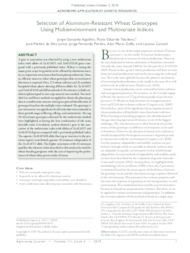Selection of aluminum-resistant wheat genotypes using multienvironment and multivariate indices.
Selection of aluminum-resistant wheat genotypes using multienvironment and multivariate indices.
Autoria: AGUILERA, J. G.; TEODORO, P. E.; SILVA JUNIOR, J. P. da; PEREIRA, J. F.; ZUFFO, A. M.; CONSOLI, L.
Resumo: A gain in association was obtained by using a new multivariate index with alleles of TaALMT1 and TaMATE1B genes compared with a previously published index. Wheat is among the major grain crops. Its growth can be affected by aluminum toxicity, an important stress factor that limits plant productivity. Thus, an efficient means to select wheat genotypes that are resistant to this stress is required. Here, 172 wheat cultivars and 23 synthetic hexaploid wheat plants showing different alleles for TaALMT1 and TaMATE1B and different levels of Al resistance in field conditions (phenotyped in two crop seasons) were studied. The modified Lin and Binns method was applied to obtain the phenotype data in a multivariate manner aiming at a general identification of genotypes based on the multiple traits evaluated. The genotype × year interaction was significant for all traits that were evaluated in three growth stages (tillering, silking, and maturation). The top 20 Al-resistant genotypes obtained by the multivariate method were highlighted as having the best combination of the main desirable traits. Correlation analysis showed a gain in the association of the multivariate index with alleles of TaALMT1 and TaMATE1B genes compared with a previously published index. The superior TaMATE1B allele (having an insertion in the promoter region) contributed a greater Al resistance independent of the TaALMT1 allele. The higher association with Al resistance qualifies the selection index described in this study to be used for wheat breeding programs with the aim of improving the performance of wheat when grown under Al stress.
Ano de publicação: 2019
Tipo de publicação: Artigo de periódico
Unidade: Embrapa Trigo
Observações
1 - Por padrão são exibidas publicações dos últimos 20 anos. Para encontrar publicações mais antigas, configure o filtro ano de publicação, colocando o ano a partir do qual você deseja encontrar publicações. O filtro está na coluna da esquerda na busca acima.
2 - Para ler algumas publicações da Embrapa (apenas as que estão em formato ePub), é necessário ter, no celular ou computador, um desses softwares gratuitos. Sistemas Android: Google Play Livros; IOS: iBooks; Windows e Linux: software Calibre.
Acesse outras publicações
Acesse a Base de Dados da Pesquisa Agropecuária (BDPA) para consultar o acervo completo das bibliotecas da Embrapa.

